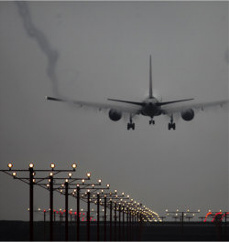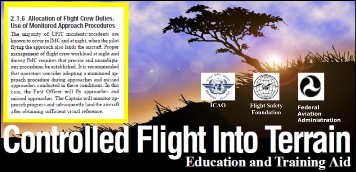
PicMA - "Pilot-in-charge Monitored Approach" - is a simple change to normal crew cockpit duties.
- Prior to starting the approach, the Pilot delegates the physical flying tasks to the co-pilot, to be able to concentrate more on managing the operation and making decisions.
- When satisfied that all the conditions for a safe landing have been met, he or she resumes physical control to land the aircraft.
- If the Pilot isn't satisfied that a landing can be made, the co-pilot carries out a go-around.

Use of this procedure for all approaches would have many safety benefits. The International Civil Aviation Organisation, Flight Safety Foundation and Federal Aviation Administration CFIT Training Aid suggests as a minimum that airlines should consider using them for "all approaches in Instrument Meteorological Conditions or at night."
Big safety benefits.....
"Monitored Approach" procedures were first developed nearly 60 years ago. They have benefits in all weather conditions, building into normal operations
- improved overall descent and approach planning and cockpit management;
- more effective monitoring, with greater assurance that errors made by the pilot flying will be corrected;
- safer transition to visual references for landing.
.... at negligible cost.
One of many Approach & Landing Accident Reduction (ALAR) safety "tools" available, PicMA is the most cost-effective, quickest and easiest to implement, involving
- zero expenditure on equipment;
- minimal training;
- usable for any type of multi-crew aircraft;
- usable on any instrument approach;
- usable anywhere in the world.
"Monitored approach" procedures are already used by many airlines in some "bad weather" conditions. However, much wider use is probably the only way to reduce "pilot error" accidents that can be achieved by action within the Flight Operations community by itself.
Doing so does not require agreement from, or expenditure by, any other party - regulators, manufacturers, or non-operational airline management. But operators trying to follow the Training Aid's recommendation will have found it difficult, due to a lack of material to "consider". Airlines are reluctant to use it, primarily because of pilot culture, misinformation and misunderstanding.
This website has been created to address those issues, as a source of explanatory and historic material on the subject.